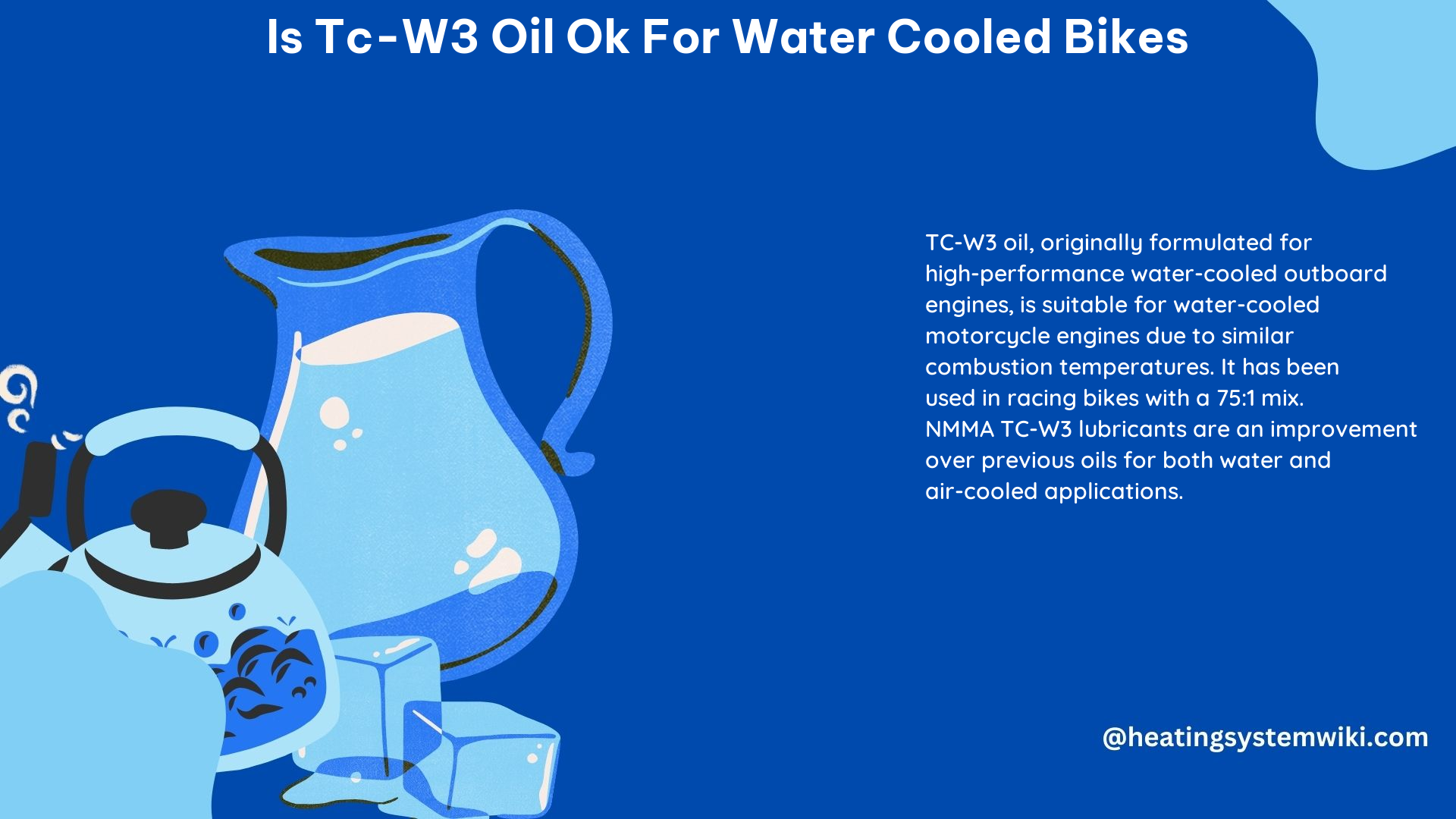The question of whether TC-W3 oil is suitable for use in water-cooled motorcycles is a topic of ongoing debate among motorcycle enthusiasts and mechanics. TC-W3 oil is primarily designed for use in outboard marine engines, but its unique properties have led some to consider it as a potential option for high-revving, water-cooled motorcycle engines.
Understanding TC-W3 Oil Specifications
TC-W3 oil is a type of two-stroke oil that meets the National Marine Manufacturers Association (NMMA) TC-W3 standard. This standard requires the oil to have the following key specifications:
- Superior Anti-Scuffing and Anti-Wear Properties: TC-W3 oils are formulated with advanced additive packages that provide excellent protection against piston scuffing and engine wear, even under high-stress conditions.
- Excellent Engine Cleanliness: TC-W3 oils are designed to keep engine components clean, reducing the buildup of deposits and sludge.
- Corrosion Protection: The formulation of TC-W3 oils includes components that help prevent corrosion of engine parts, particularly in the presence of water.
- Compatibility with Outboard Engine Materials: TC-W3 oils are specifically designed to be compatible with the materials used in outboard marine engines, including seals, gaskets, and other engine components.
These properties make TC-W3 oil a potential candidate for use in water-cooled motorcycle engines, as they share some similarities in terms of operating conditions and engine design.
Potential Benefits of Using TC-W3 Oil in Water-Cooled Motorcycles

-
High-Revving Engine Performance: Many water-cooled motorcycle engines are designed to operate at high revolutions per minute (RPM) to deliver impressive power and acceleration. The anti-wear and anti-scuffing properties of TC-W3 oil may help maintain engine performance and longevity under these demanding conditions.
-
Corrosion Protection: The corrosion-resistant properties of TC-W3 oil can be particularly beneficial for water-cooled motorcycles, as the presence of water in the cooling system can increase the risk of engine component corrosion.
-
Improved Engine Cleanliness: The detergent and dispersant additives in TC-W3 oil can help keep engine components clean, reducing the buildup of deposits and sludge, which can improve overall engine efficiency and longevity.
-
Compatibility with Seals and Gaskets: The compatibility of TC-W3 oil with the materials used in outboard engines may also make it a suitable choice for water-cooled motorcycle engines, as they often use similar seals and gaskets.
Potential Drawbacks and Considerations
While the potential benefits of using TC-W3 oil in water-cooled motorcycles are compelling, there are also some potential drawbacks and considerations to keep in mind:
-
Compatibility with Engine Design: Not all water-cooled motorcycle engines may be compatible with TC-W3 oil, as the formulation may not be optimized for the specific materials and design of the engine. It is essential to consult the manufacturer’s recommendations before using TC-W3 oil.
-
Viscosity Concerns: Some TC-W3 oils may have a higher viscosity than the recommended oil for a particular water-cooled motorcycle engine, which could lead to increased drag, reduced fuel efficiency, and potential lubrication issues.
-
Availability and Cost: TC-W3 oil may not be as readily available as traditional motorcycle-specific oils, and it may be more expensive in some regions, which could be a consideration for some riders.
-
Warranty Implications: Using TC-W3 oil in a water-cooled motorcycle may void the manufacturer’s warranty if it is not explicitly approved for use in that specific engine. It is crucial to check the warranty terms before making the switch.
DIY Guide: Changing Oil in a Water-Cooled Motorcycle using TC-W3 Oil
If you decide to use TC-W3 oil in your water-cooled motorcycle, follow these steps for a successful oil change:
-
Gather the Necessary Tools and Materials: Prepare a oil drain pan, funnel, oil filter wrench, new oil filter, and the appropriate amount of TC-W3 oil for your motorcycle’s engine capacity.
-
Warm Up the Engine: Run the engine for a few minutes to warm up the oil, making it easier to drain.
-
Drain the Old Oil: Place the drain pan beneath the oil drain plug, remove the plug, and allow the old oil to drain completely.
-
Replace the Oil Filter: Locate the oil filter and remove it using the oil filter wrench. Lubricate the gasket of the new filter with a small amount of TC-W3 oil before installing it.
-
Add the New TC-W3 Oil: Using a funnel, pour the recommended amount of TC-W3 oil into the engine, taking care not to overfill.
-
Dispose of Old Oil and Filter: Properly dispose of the used oil and filter according to local environmental regulations.
-
Start the Engine and Check the Oil Level: Start the engine and let it run for a few minutes to ensure proper oil circulation. Check the oil level and add more TC-W3 oil if necessary.
Remember to always consult your motorcycle’s owner’s manual and the oil manufacturer’s recommendations to ensure the proper use of TC-W3 oil in your water-cooled motorcycle.
Conclusion
The use of TC-W3 oil in water-cooled motorcycles is a topic that requires careful consideration. While the oil’s unique properties may offer some potential benefits, it is essential to ensure compatibility with your specific motorcycle engine and to follow the manufacturer’s guidelines. By understanding the technical specifications of TC-W3 oil and following a proper oil change procedure, you can make an informed decision on whether it is the right choice for your water-cooled motorcycle.
